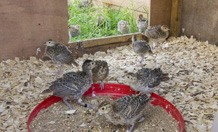
The birds studied lived on a shooting farm in Hampshire. Image courtesy of Mark Whiteside
Changes to environment helps protect young pheasants
Making changes to the early lives of young pheasants can help prevent them dying needlessly, University of Exeter researchers have found.
Creating a three-dimensional environment for birds bred for field sports can help many more survive when they are released into the wild, a new study shows.
Giving pheasants raised perches in their pens during their first seven weeks helps them grow larger with bigger leg bones, fly higher and grasp, and roost off the ground safe from predators. This makes them less likely to be killed than birds bred without perches.
Researchers also discovered the introduction of raised perches helps pheasants develop better spatial awareness and memory. This may enable them to remember where good sources of food could be found, and therefore thrive in the wild.
The birds studied lived on a shooting farm in Hampshire, the Middleton Estate, and the research was carried out in partnership with the Game and Wildlife Conservation Trust. They were observed over two seasons.
More than 40 million pheasants are released into the UK countryside each year, and around a quarter die because they come into contact with predators. This is thought to be because an intensive rearing environment does not allow the development of essential survival characteristics.
Experts involved in the study manipulated the environment of the pheasants in an effort to make it more realistic. This allowed reared individuals to perform a greater range of behaviours and will better prepare them for release into the wild.
As part of the study academics had to follow the pheasants around the Hampshire countryside in the dark, wearing night vision googles, to discover where they had roosted.
Birds naturally use elevated perches to roost at night as a form of anti-predation behaviour and in the wild, pheasant mothers give calls which draw chicks up to roost on elevated perches. An absence of perches during early development may inhibit individual opportunities for learning and development.
The pheasants studied were less likely to die of natural causes in the six months after release into the wild, but differences in mortality were lost over the following breeding season.
Dr Joah Madden, from the Centre for Research in Animal Behaviour, one of the researchers on the study, said: “It is economically, ethically and environmentally very wasteful for so many pheasants to die so early on in their life.
“Our study shows that even when reared in the absence of their parents and under unnatural conditions you can help pheasants develop physically, behaviourally and cognitively which leaves them less vulnerable and more likely to succeed in the wild.
“The pheasants hadn’t had the same experience of learning to get higher up to escape foxes and other predators. We gave them opportunities to develop their muscles so they had stronger legs.”
GWCT research head, Dr Rufus Sage says: “A key aim of the pheasant research at the GWCT is to improve the sustainability credentials of releasing for shooting. In particular we want to minimise the unwanted impacts of releases on the environment. This research shows how we can achieve this by releasing fewer fitter birds. It may also be that these fitter birds can go on to initiate wild breeding populations and we have a new study with Exeter to look at this.”
This research carried out in partnership with the Game and Wildlife Conservation Trust aims to improve the conditions of game bird breeding. The research group at the University have already established pheasant health and survival prospects can be improved through changing their diet.
The study, Multiple behavioural, morphological and cognitive developmental changes arise from a single alteration to early life spatial environment, resulting in fitness consequences for released pheasants, is published in Royal Society Open Science.
Date: 23 March 2016
